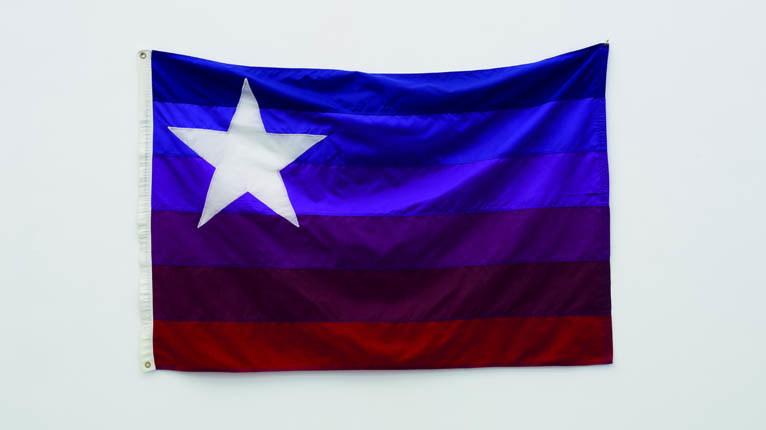MINISTRY OF TRUTH
| June 13, 2012 | Post In LEAP 14

Boers-Li Gallery has ventured into discourses of ideological hegemony and its propagation in the new group show, “Ministry of Truth.” The modest collection of works seeks to challenge narratives that sustain both political and personal power structures, featuring artists working in and across North America, Europe, and Asia. But if the exhibition’s goal is to critique knowledge conscribed within political boundaries, the title of the show, like that of the department in 1984 that it is named after, is a misnomer. Just as the literary Ministry of Truth was not responsible for protecting the truth— its duty instead to spread propaganda and obfuscate history— the exhibition “Ministry of Truth” is not so much a critique of narratives of power as it is a creation of its own narrative.
The show’s targets are not consistent. Sometimes they are states, as in Jonathan Monk’s The World in Stars and Stripes, a world map composed entirely out of the American flag. “In one word, it creates a world after its own image,” and exactly as Marx and Engels foretold, the flag-as-map is the visual embodiment of global American hegemony. Another Jonathan, surname Horowitz, also employs the flag, not so much to critique the United States as to express its latest and greatest anxiety: New American Flag Made in China remakes the original with a single star instead of fifty, and stripes that move from blue through purple and mauve to red.
Photographs by Trevor Paglen, however, are legitimately subversive. A series of five photographs documents places that are both off the map and off-limits— secret American military bases, drones, and classified satellites. In Orwellian terms, these are images that the American government, for obvious reasons, would rather have sent down the memory hole, obliterated by furnaces roaring somewhere beneath its Ministry of Truth. Here, they contribute to the show’s effort to expose inconvenient truths, and the photographs are presented as equal parts evidence and art objects.
But not all works in the show have such sharp geopolitical claws— Pillow Talk Story, also by Jonathan Horowitz, highlights the sexual politics of power games in an installation featuring a double bed draped in white sheets with personalized “him” and “hers” pillows. The set of pillowcases revolves to make bedmates of historical and fictional personalities: Nixon and Mao, Gertrude and Alice, R2-D2 and C-3PO. Sam Samore’s Veritas, a video work filmed in Beijing and Paris, wanders between melodramas of the everyday (jealous lovers, the crush of urban living) and the eternal truths of existence (the meaning of love and life). An installation by Qiu Xiaofei is even more oblique. Mountain Behind Wood Behind Mountain is an almost formalist attempt to expose the frames of perception— three wooden easels sit on the gallery floor, one of them holding an oil painting that depicts the same easels in the same arrangement against mountains and sky. Last, Yan Xing takes a DIY, interventionist approach with SEXY, in which he strokes himself while wandering nude amongst rocky cliffs, and Goodbye, in which he left notes with magazine cut-outs of the words “goodbye” at 35 random doors.
The critical focus of “Ministry of Truth” is fragmented— works by American and European artists largely target political hegemony, mostly of the American variety, while works by their Asian peers highlight more abstruse issues of perception and space. The links between the works are tenuous to the point that the theme just doesn’t hold water. Instead, “Ministry of Truth” seems to function more as an expression of its own ideology of the contemporary: that art should be critical, that it should span multiple mediums, that its creators should be cosmopolitan and their backgrounds diverse, and that it should be politically relevant, or at least assume such a posture. Angie Baecker

